#class essay
Text
Pilgrimage and the Lands of Lothric: The Medieval Narrative in Dark Souls III
Here is the essay that got me started on my route of video game studies and digital media. I was taking a class with a medievalist professor that was talking about the ways that medieval themes and thoughts are still prevalent in the world today. She is a huge soulsborne fan so when I pitched this idea she was super into it, with this essay going on to become my grad school application essay. I hope you enjoy it!
Pilgrimage and the Lands of Lothric: The Medieval Narrative in Dark Souls III
I. Introduction
Dark Souls III is, although frequently lauded, a very opaque narrative. Little of the narrative is told to the player at any point during the thirty to forty hours of grindingly difficult roleplaying game action and adventure. What little bits of story are present, however, are delivered from sought out sources, such as non-player characters (NPCs), items descriptions, and flavor text throughout the game world, as well as inferences from the dilapidated kingdom of Lothric that the player gets to explore on their quest to “link the fire” on behalf of one of the few more friendly characters that they come across during their time in the game. In this paper I am going to summarize the general overview of the story of Dark Souls III and show that it is a modern analogue to the pilgrimage practices of the Middle Ages. In doing so, this paper strives to shed some light into the abyss that is the in-game lore plotted so masterfully by FromSoftware, the studio behind the Souls series.
II. Background
Opening up with a cinematic, Dark Souls III lays out the four bosses that the player must fight, explaining that, “In venturing north, the pilgrims discover the truth of the old words. / ‘The fire fades, and the lords go without thrones,’” [1] as part of the sixteen lines that accompany the showcase of the world and bosses before the game actually starts (Dark Souls III). From here, the game does not volunteer much other information, aside from brief sections of dialogue when interacting with the NPCs that are necessary for game progression.
As to set a baseline to draw from, then, here is a manual explanation of the main events of the game and its world: Dark Souls III cast the player as “the unkindled one,” an undead being who is awoken in response to the fading of the light of the world in order to restore, “link,” the flame and continue the current in-world epoch, the Age of Fire (Dark Souls III). Along the way, the player is tested in several environments that are central to the narrative, as FromSoftware relies heavily on the environment to form the majority of its storytelling, each of which is usually completed with the defeat of one of the games many bosses. Four of these such bosses, which the player must seek out, are called the Lords of Cinder, each of which has abandoned their duty to continue the light of the world, and therefore must be fought and their cinders brought back to rekindle the first flame. Once that is finished, the player is given a few choices based on their actions in the game in a kind of moral choice ultimately; do you link the fire, continuing the age limping along, extinguish the fire and let the next age of humanity begin, or do you usurp the fire and become a god yourself?
The world of Lothric itself begins in a sort of high citadel, The High Wall of Lothric, before the player descends into the dilapidated lands of the Undead Settlement, Road of Sacrifices, and Farron Keep and its swamp, all of which have a sort of overgrown, crumbling aesthetic of a tightly packed and mountain-locked countryside. From there, however, the player wanders through the ruined underground of the Catacombs of Carthus, a winding tunnel that eventually leads to the societies of old and the mythic city of Irithyll of the Boreal Valley and Anor Londo, where the old gods once lived. Lastly, the player descends into the depths again in search of the Profaned Capital, before returning to Lothric Castle to face off against the rulers of the land themselves, the twin princes Lothric and Lorian. The entire movement of the game is based on looping back to places that are familiar and making shortcuts between places that are safe to get quickly through dangerous areas that would otherwise be tedious and difficult to pass through separately. This whole journey is punctuated by bonfires, checkpoints where the player gets the chance to rest and level up and do all the other things that are central to gameplay mechanics. One of the most vital being the recovery of what the game calls “Estus Flasks” but are essentially healing items that hopefully keep the player from getting killed and having to reset to the last bonfire they visited (Dark Souls III).
More specifically, the world of Lothric is intentionally meant to be oppressive as the player makes their way through the course of the game. The landscape is made up of harsh cliffsides and thin pathways, ravines that lead down to bottomless pits, and overgrown roots that make almost every surface feel unstable. When there is architecture in the world, it takes on either a sort of ramshackle and dangerously leaning appearance in the case of the spaces like The Undead Settlement, where it is clear that the place may have once been a kind of pleasant village but was patched and repaired over and over again into barely standing structures. Otherwise, the architecture is grand, heavy, and old medieval styled. These are usually the places that have some additional historical importance to the game world, such as Lothric Castle, the home of the twin princes who rule the kingdom. Though even these structures are falling apart, tied to the themes of the game, and most of the locations that the player visits have long past their prime when they are visited. For example, the Cathedral of the Deep, an area once home to a legendary Lord of Cinder, is now nearly empty, with tattered cloth all over the floor and walls, as well as the central chambers all having been filled with a sort of black sludge (Dark Souls III). The pathways through these places are, in many cases, actual roads that have been left to the sands of time and have not been kept up, not dissimilar to the old Roman roads that were left behind after the collapse of the empire.
On another note, though also necessary for the background of this paper, is the term “narrative” in reference to videogames has been a subject of some debate, due to the non-linear nature that many games take in their storytelling (Ryan-Thon, 173). Dark Souls III, however, sticks to a relatively linear structure in its plot and keeps the important information in sequence. Therefore, in this instance “narrative” will serve as a good term to examine the story being experienced by the player and make it easily relatable in the context of literary pilgrimage narratives. In his chapter on game abstraction in Storyworlds across Media: Toward a Media-Conscious Narratology, Jesper Juul also suggests an alternative phrase, “fictional world” (Ryan-Thon, 173), following in the footsteps of a similar phrase used by Jan-Noël, “Storyworld” (Thon 289). While both of these are good alternatives, they will be employed here more specifically to refer to the world of Lothric that Dark Souls III is set in, as the world space itself is a core part of what makes the game a game and allows it to communicate its message.
Finally, in terms of background, there is the more formal games language that is used to describe Dark Souls III on a kind of meta level. The game is considered to be a roleplaying game (RPG) due to its elements of levelling up and encouragement of the player to approach problems in-game with a variety of different strategies. The setting invokes the traditional hallmarks of the medieval fantasy genre as well, as the player encounters knights, dragons, giants, castles, kings, and princes. With this established, invoking the Middle Ages as pretext for the storyworld (Eco, 68), a baseline understanding of the game and its tone has been established.
III. Foreground
Religious pilgrimage is almost synonymous with the Middle Ages and was an important part of the travel culture at the time. Roads themselves were recognized as being extremely valuable and were supported often by those who could afford it, especially those main thoroughfares that would take merchants, pilgrims, and general travelers across medieval European landscapes (Allen, 27). Pilgrims in particular made a core part of the necessity of roads as the quest they undertook was both holy (Osterrieth, 146) and economically beneficial for pilgrimage sites (Osterrieth, 153-4; Salonia, 3). What makes a pilgrimage distinct from other travel through the medieval landscape, however, is that they often focused on the relics and holy places of Christianity (Salonia, 3). Matteo Salonia suggests, in his article, “[The] reverence and physical journeys towards relics and saints were less theologically controversial than reverence and pilgrimages towards holy sites because of the new place assigned to the human body within Christian cosmology,” a sentiment that is mirrored in the bodily nature of the travel that would take place to visit such a relic (Salonia, 5). This is tied into a sort of Medieval Christian interest in the body, specifically the body as a means to channel spiritual energy into miracles and shows of faith (Salonia, 5). This differed from the Platonic view that had dominated before the Christian tradition, which placed the body as adversarial to the mental and spiritual pursuits of an individual (Salonia, 6).
Anne Osterrieth, in her article on pilgrimage as a personal quest, comments on the body-centric nature of the pilgrim’s movement, saying, “The pilgrim also drew pride from his capacity to undertake his task. He was becoming a seasoned traveler and derived pleasure from this new competence” (Osterrieth, 152). In popular media, which depicts pilgrims in a much more dower light, this attribution and celebration of prowess seems almost antithetical. However, Osterrieth emphasizes the pilgrim’s journey as one of death and rebirth, from the person they were who needed divinity into the person who has come in contact with divinity and is ready to advise the next on their journey (Osterrieth, 152). This shows that the person on a pilgrimage was, of course, seeking out a relic or holy place to venerate and receive blessings from, but also that along the way there is an unintended but necessary physical growth as they become a competent traveler and learn to deal with the challenges of long road travel.
This travel was far from unguided otherwise, as people consulted other travelers, maps, or guides to get them to their shrines of destination (Allen, 28). In the minds of the pilgrims, explored by Valerie Allen, the road was not always present, “we might call this [instrumental] representation of the road as means to end the default understanding of roads, in which they function as connectors between settled communities” (Allen, 33). Allen is looking at the pilgrimage narrative in the Book of Margery Kempe, which describes the travels of 15th century titular businesswoman, Margery Kempe (Allen, 27). This narrative, however, is where Allan draws the almost complete disregard of the road from, as it seems that Kempe herself did not find that part of the experience worth keeping track of in the same detail as the rest of her visits and exploits (Allan, 29).
Ritual, here, becomes a big part of the discussion of pilgrimage, which is itself inseparable from conceptions of rituals. “Ritual as a type of functional or structural mechanism to reintegrate the thoughtaction dichotomy, which may appear in the guise of a distinction between belief and behavior or any number of other homologous pairs,” is a definition of ritual put forward by Catherine M. Bell, in her work, Ritual Theory, Ritual Practice (20). She goes on to summarize that ritual is always tied to opposing forces in a culture or system of practice (Bell, 23). This provides a kind of structure that creates something of a cultural habit, something that fascinated scholar Pierre Bourdieu, is part of a kind of societal generative principal (Bourdieu, 78). Bourdieu takes this idea into a kind of forgetting of history and being left with only practice (Bourdieu, 79), which in some ways can be seen in some of the later ideas of pilgrimage to non-religious places or referring to the colonial settlers in America as “Pilgrims.” These tie into the discussion of pilgrimage as it establishes that pilgrimage as a ritual is always opposed to something else. In the case of historical pilgrimage this tension is between the safety of the village and staying in one place and the fulfillment of the journey at the end of a long and dangerous road.
IV. The Ground
Pilgrimage and Dark Souls III already share one thing in common, though debate has ensued about what role this takes in the narrative sphere (Bierger, 11), and that is the central necessity of space. It is space and travel that characterize a Pilgrim wandering medieval England, as well as the player character in Dark Souls III, embarking on their journey into the world of Lothric to link the fire. While the literal space is different, as there is the space that it takes to physically walk from place to place, there is a kind of abstracted sense of space that is present in Dark Souls III that is necessary for the nature of the story world (Ryan-Thon, 183). In this space between destination and starting point is where the pilgrim acquires their expertise and endures the hardships that will form them into the person worthy of accepting the blessings at the relic when they arrive (Osterrieth, 152). While in the game, the path works on a very similar level, having the player face challenges and gain experience to level-up their character so that they have the necessary competence when they come to face a boss like the first Lord of Cinder, the Abyss Watchers. Both the pilgrim and the player come across these various challenges, twists in the road, wild animals, other people threatening them, they also come across various moral encounters as well, such as to give aid or do favors for those they meet. In the reality of the past, this was much more literal, while in Lothric these moral actions take the form of side quests more often than not. In one example of a moral action that can be taken in the game early on in the Undead Settlement area, the player finds a woman, named Irina of Carim, trapped with a knight nearby. The player is told by the knight, “taken an interest in her, have you? Well, she's a lost cause. Couldn't even become a Fire Keeper. After I brought her all this way and got her all ready. She's beyond repair, I tell you" (Dark Souls III). To actually save her, if the player wants to, the process is pretty involved and includes gathering a whole other trail of items to get the door to Irina open. Alternatively, there is no real punishment for the player avoiding this action, much like in real life, and all further interactions and possible benefits of the NPCs are lost.
The main idea linking these two actions is the concept of The Quest, which is incredibly broad. But more specifically, the quest for contact with divinity, during which the central actor develops their own abilities in order to be ready to receive the divinity when the time comes. While this is plainly evident in the nature of the pilgrimage, in Dark Souls III the same concept applies. This is due, in-part, to the transmedial principal of minimal departure that was developed by Marie-Laure Ryan and adapted by Thon. The principal is “at work during narrative meaning-making that allows the recipients to ‘project upon these worlds everything [they] know about reality, [making] only the adjustments dictated by the text’ (Possible Worlds 51). It is worth stressing, though, that recipients do not ‘fill in the gaps’ from the actual world itself but from their actual world knowledge” according to Thon as he cites the original principal by Marie-Laure Ryan (Thon, 292). This principal allows for the game world of Dark Souls use the quest form much more naturalistically, allowing the player to take on the grand quest of their own pilgrimage through the Lands of Lothric in a mentally analogous process.
There is a pilgrimage here is part of the very core of the gameplay of Dark Souls III, as well as the narrative proper. Throughout the game, the player is told that it is their job to gather the necessary relics in order to link the flame, a process that proves an arduous journey and a game experience that FromSoftware has come to be known for. On the level of environment alone, there is a similarity here to the kind of landscape that a pilgrim might move through in medieval Europe, with its crumbling, ancient, ruins and overgrown roads. The oppressive and dark game atmosphere with the bonfires as checkpoints give a sense that would be not too dissimilar to that of a real-world pilgrim, going on an arduous journey only to find rest at a campfire by the side of the road. It is significant as well, that, in the very last segment of the game, the place that the player finally arrives at is a religious site, the city of Irithyll, where the most prominent buildings are those of churches. In this game area the player visits three, one called The Church of Yorshka, one that is unnamed but is home to the boss Pontiff Sulyvahn, and finally the grand cathedral of Anor Londo, where the gods once made their homes and is now home to Aldritch, a kind of heretical saint (Dark Souls III). It is after this point that the player must return to the starting citadel of Lothric to continue their journey.
It is also at this point of the game, as the player has made their way all around the kingdom of Lothric and even to places from the first couple of games in the Souls series, that this quest has been done before by others in the storyworld as well as by scores of other players before them. Combining this with the lack of direct story throughout the game, makes the player an agent in the meaning-making activity that the game has you go through, creating a kind of “intentionless action” (Bourdieu, 79). That is to say, with how little the game tells the player before their pilgrimage begins, the player is left to follow the game path and explore the story for themselves without fully clear intentions for what it is the in-game character is actually participating in. This is, in action, the kind of ritual repetition that leads to the unconscious repetition of the history of the players actions in the Bourdieusian sense (Bourdieu, 78).
Where the pilgrimage metaphor really comes full circle, however, is in the difficulty. It’s ironic to compare a medieval pilgrimage’s difficulty a videogame, but in its own space the Souls series stand as monoliths of difficulty. This difficulty, which is formed from a balance of timing-based combat and harsh punishments for failure, creates a kind of demand for focus. Whether the player wants to or not, the nature of the game demands that they pay full attention or risk losing hard-earned progress. This leads to, a kind of phenomenon where the player becomes more focused on the skill-based challenges and tunes out (or abstracts) for themselves the more complex elements of the game during the challenge (Ryan-Thon, 185-6). In a way not dissimilar from what Allen noticed with the Pilgrimage of Margery Kempe, where the repetitive action of travel was not as memorable as the destinations, the challenges and skill building (leveling up) being secondary to the large experiences of destinations (boss fights). Both walking for days and grinding through difficult game areas build patience in those who partake in each activity as well, becoming something of a meditative activity (Unknown, “Dark Souls is More than Just a Game”).
The moral component, while hard to measure, is an example of some micro-moral game morality throughout most of the game, much like in real life (Ryan et al, 57). However, much like the pilgrim’s ultimate quest being tied to the much more cosmically important goal of the afterlife of their soul, so is the ultimate morality of the quest in Dark Souls III, a large macro-moral choice to determine the fate of the storyworld (Ryan et al. 57). However, this is the area where Dark Souls III, much like other remakes and updated retellings of the stories of the past, adds in its own twist. The three endings of the game, usurping, letting die, or carrying on the flame, constitute a moral ending that does not present itself in the traditional stories of pilgrimage. Instead, the game asks its player at the very end of the game what they believe the best course of action is for the storyworld, one that has been limping along since the very first game in the series. This macro-moral decision is almost jarringly major in comparison to what minor interactions that the player has had up until that point and brings a sense of ultimate closure no matter what ending is taken. The game of course has additional content and gameplay to enjoy after the credits roll, but the narrative itself concludes finally in one of three ways. Each option, however, recolors the actions that the player took to get to that point, either as a would be king of humanity, a savior sacrificing themselves to keep the world going for another cycle, or as a savior in another sense, finally letting the limp and broken world fade into darkness.
V. Conclusion
From the content on the story itself, a lone character looking to keep the fire of the world burning and trekking across the land of Lothric, to the player’s experience of the game play, Dark Souls III sets itself in the same style of narrative as that of the experience of pilgrims. Both game and historic action culminating in a building of skills and triumph over adversity that many others may not be willing to undertake. Even with little motivation in a bleak and harsh world that appears stacked against almost every move that the player and their character work towards. While Dark Souls III may only be channeling this kind of mentality for the benefit of the player’s experience, it casts its spell regardless and has left a lasting impression on both individuals as well as the games industry as a whole (resulting in the Soulsborne game genre). However, more than just affecting the entertainment industry as a whole, Dark Souls III gives a mediated experience of one of the time-honored traditions that was once a massive undertaking across Christendom, calling up the past as it seeks to tell its own story about a medieval-like fantasy world, and also the unidyllic descent into ruin that every age face, both in the world of the game and outside of it. From a narratological perspective, it gives an interesting challenge to where the border between game world and narrative actually divides two different experiences. While from a medieval perspective, it gives a unique look into the kind of crumbling and uncertain side of what history used to be through player experience. And all of that is without delving into the rich optional or expanded content that was added after the original release of the game.
Bibliography
Allen, Valerie. “As the Crow Flies: Roads and Pilgrimage.” Essays in Medieval Studies 25 (2008): 27–37.
Bell, Catherine M. Ritual Theory, Ritual Practice. Oxford University Press, 2009.
Bieger, Laura. “Some Thoughts on the Spatial Forms and Practices of Storytelling.” De Gruyter 64 (2016): 11-26.
Bourdieu, Pierre. Outline of a Theory of Practice. Cambridge: Cambridge University Press, 1997.
Eco, Umberto. "Dreaming of the Middle Ages." Faith in Fakes: Travels in Hyperreality. Transl. William Weaver. 1973. London. (1998) 61-72.
Miyazaki, Hidetaka. Dark Souls 3. Bandai Namco (2016).
Osterrieth, Anne. “Medieval Pilgrimage: Society and Individual Quest.” Social Compass 36 (1989): 145-157.
Ryan, Malcolm et al, “Measuring Morality in Videogames Research.” Ethics and Information Technology 22 (2020): 55-68.
Ryan, Marie-Laure, and Thon, Jan-Noël, eds. Storyworlds across Media: Toward a Media-Conscious Narratology. Lincoln: University of Nebraska Press, 2014.
Salonia, Matteo. “The Body in Medieval Spirituality: A Rationale for Pilgrimage and the Veneration of Relics.” Interdisciplinary Journal of Research on Religion 14 (2018): 1-10.
Thon, Jan-Noël, “Transmedial Narratology Revisited: On the Intersubjective Construction of Storyworlds and the Problem of Representational Correspondence in Films, Comics, and Video Games” Narrative 25 (2017): 286-320. Unknown, “Dark Souls is More than Just a Game” GameFAQs (August 30th, 2014) https://gamefaqs.gamespot.com/boards/606312-dark-souls/69969309
[1] Quotes from in-game dialogue are sourced from https://darksouls3.wiki.fextralife.com, a website that has transcribed the text of Dark Souls III’s dialogue and other in-game text in its entirety.
#Medieval#medievalism#pilgrimage#essay#my essays#class essay#dark souls#dark souls 3#soulsborne#undergrad research#narratology#world building#video games#medieval literature
24 notes
·
View notes
Text
another cool thing is when you devour a book over the course of a handful of hours and it fucks you up and you just have to lie on the couch feeling like your brain went swimming for too long & only just came up from under the water. art is so good
#musings#i missed reading things…#more specifically. things not for class#things i don’t have to write essays on. those things
24K notes
·
View notes
Text


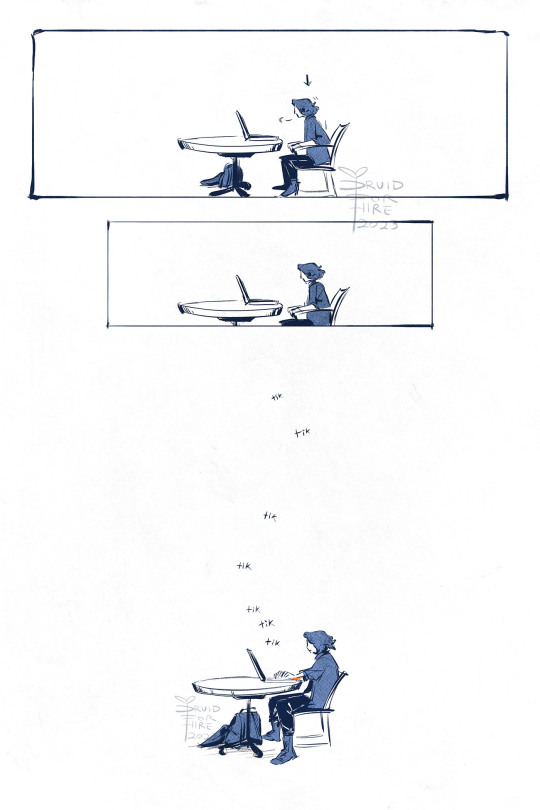
[images ID: three images of a comic titled "one must imagine sisyphus happy" by druid-for-hire. it is a visual narrative beginning with someone with wrist pain (depicted by bright orange nerves) working at a drafting table. the reader is shown the same wrist as the person uses it for many everyday tasks such as carrying a grocery basket, pushing elevator buttons, typing, and doing dishes, until the pain dissolves all the panels into chaos. the person then performs several physical therapy exercises until the pain subsides. they sit back down at a desk with their laptop, sigh, and begin typing. a small spark of pain reappears. end id]
a fun little piece i made during the semester and submitted into our school comic anthology! (which you can buy at the Static Fish table at MoCCAFest in NYC ;] ). it's about artists and injury
#comic art#comics#original comic#chronic pain#carpal tunnel#tendonitis#my art#original#edit: what a delightful surprise to see this take off#this was made for class on very low fuel and very few thoughts and late at night and exhausted#the prompt was just a wordless narrative essay. three pages. and i had nothing and no ideas#and my head hurt and i was too tired to think about doing any of the like. research and mind mapping and ideating i'd do otherwise#but my arm hurt#so i decided to do a thing about arm hurty#i'm surprised to see so many people finding it resonating with them#but then again i shouldn't be. the universal lies in the specific#i should make more things about smaller stuff
11K notes
·
View notes
Text



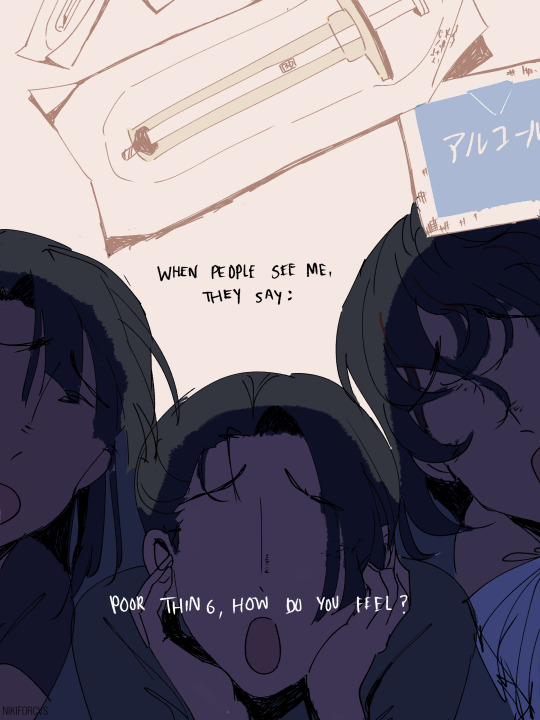

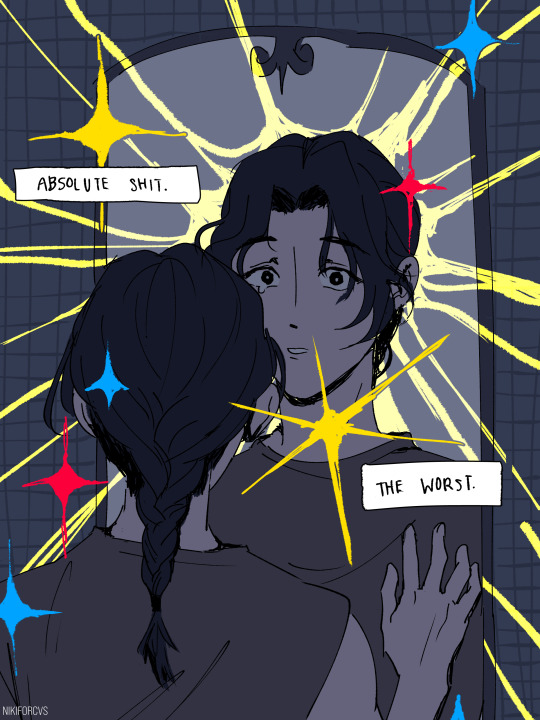

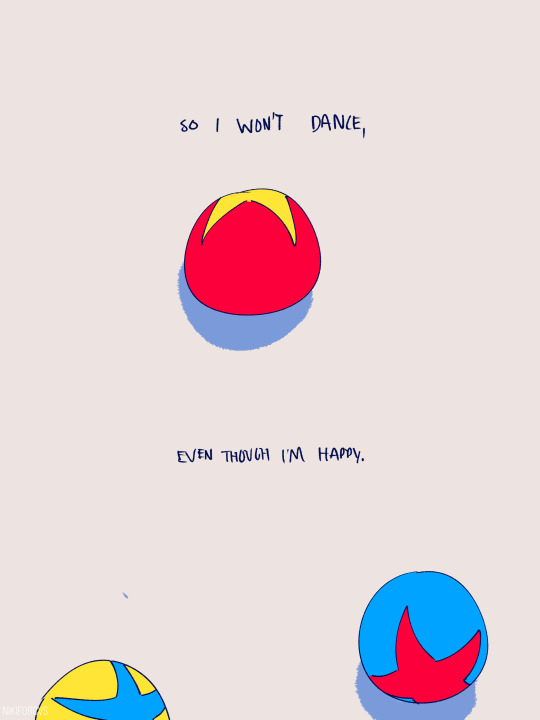

pick your battles
#my art#my stuff#art#comic#original art#pride 2024#pride month#trans allegory..... or not even allegory. just trans .... ^_^#i technically cannot come out yet but i don't think the people who i need to not see this stalk my tumblr#i know they stalk everything else like my twitter and my instagram but this might be safe#so fuck it we yap. this is a comic about picking your battles#this is a comic about how for almost a year now everyone at home in singapore has been crying about my sore throat#my terrible fucked up voice. my you know. etc#i came out as not cis and using they/them pronouns in 2015 when i was 14#but no one ever used my pronouns. none of my classmates or friends even up until i left for college in 2020#from 2020 onwards every year i wrote an angry vulnreable essay about how much it hurts that they dont remember#and people would dm me apologizing on their hands and knees and commending my bravery#and then forget about it all over again. id ont mean 'they misgender me and then catch it and apologize and correct themselves'#i mean they dont even get that far#and so you might ask yourself: why have you kept them around all this time?#and i would have to explain that by pure bad luck i grew up in the most conservative close minded community#that all of my ex classmates that stayed in singapore are cishet and upper middle class and chinese singaporean#that i Am the trans person. that they were able to ignore me for a decade partially because there was no one else#so this is a comic about how there is dignity and grace in staying in the closet sometimes#about how not everyone deserves to see you at your happiest. about how some people can go fuck themselves#you know your truth and THATS THE ONLY THING THAT MATTERS!!! YEAH!!! i love you
1K notes
·
View notes
Text
schools deleting your school email account with 7 years of documents attached to it after you graduate should be illegal and i’m not kidding
#bothering the shit out of me that i cant remember what movie i did my final essay in my senior year film class on#and i cant ever find it again because my high school deleted my account
4K notes
·
View notes
Text
Something I always thought was cool about the Frankenstein story is the details of Victor creating the creature, like he’s doing it just to prove he can- haphazardly stitching and stapling limbs of strangers together to create a bastardized monster. In every movie the creature is so gnarly because he’s not meant to loved, even by his creator, and he has scars and bolts stuck in his neck (sometimes) to show it
AND something I really love in Lisa Frankenstein is that while Lisa didn’t physically bring the creature to life she dedicates all of hers to protect and nurture him back to humanity. She loves him. And she’s a professional seamstresses so when she replaces his body parts—with those of people who have hurt her, ending their lives to further resurrect the creature so he can become the partner she longs for— it’s done delicately and purposefully and intimately and lovingly. Oh my god. In this essay I will
#I wrote this instead of my class assigned analysis essay. passion leads the hand idk what to tell you#lisa frankenstein#I miss being in the school newspaper so bad#horror#frankenstein's creature#frankenstein
1K notes
·
View notes
Quote
For men like me, spin is hard. Not just the workout, but the vulnerability: letting go of competition and leaning into the group, a dying of self so the room can revive.
New Longreads essay alert! In “Communion,” Nashville writer Raleigh McCool writes about loneliness, the desire for friendship, and finding connection in an unlikely place: spin class.
#longreads#writing#essay#reading#spin class#spin#exercise#masculinity#loneliness#friendship#connection
736 notes
·
View notes
Text
Female Guidance in Aventurine's Life
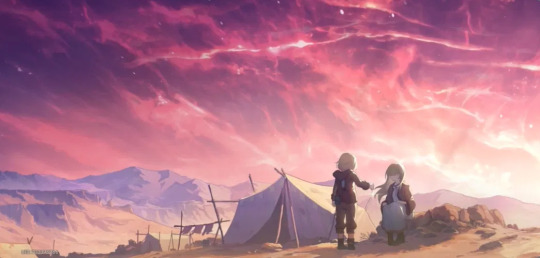
One thing I haven't seen discussed in much depth yet, but which I think is especially interesting, is the consistency of female guidance in Aventurine's life: Every single person who we have seen on screen offering Aventurine assistance or making a positive difference in his life is female (with one exception, yes, I'll get there).
Under the read more cause it's longggg:
Before even diving into his family, let's just get the obvious out of the way: Aventurine is, at least supposedly, blessed by a goddess. The very origin of his good fortune--be it actual blessing or curse--comes from the literal "mother goddess" who watches over him. This is one of the only instances in Star Rail where a god character is specifically given a gender, and Gaiathra is not ever ambiguous. She is the classic female fertility goddess with all the trappings of other famous triple goddess figures of the real world. Aventurine's personal belief in the goddess may be shaky, but he nevertheless continues to treasure his people's faith. Thus, at the core, we can say Aventurine is a character who is guarded by the most quintessential mother figure possible.
Now, with the most obvious out of the way:
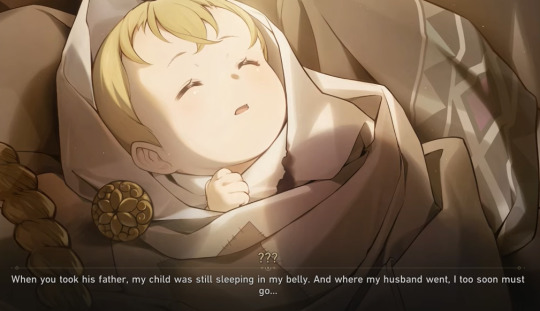
We know that Aventurine's father died before Aventurine was even born, and therefore he would not have any memories of his father, leaving him to be raised by his mother and sister.
Both women clearly made an enormous and lasting impression on Aventurine; they haunt every single one of his memories of Sigonia and are the key elements of the family Aventurine longs to return to. While he flirts with the concept of death as a way to see his family members again, it was also his mother and sister who instilled in him any sense of self-worth and meaning to his existence, the only things keeping him from giving up on living. His mother believed him to be blessed; his sister insisted to his face that not even the only remaining remnant of their mother had any value in comparison to his life.
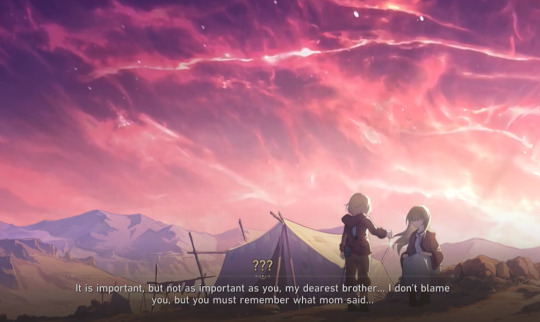
It is for his sister that Aventurine first begins expressing a self-sacrificial nature, and from his sister that this self-sacrifice is reinforced when she uses herself as a shield to help him escape massacre at the hands of the Katicans.
It is also from his sister that Aventurine learns many of the deeply meaningful actions he holds onto to the present day, despite having been so far removed from his own culture.
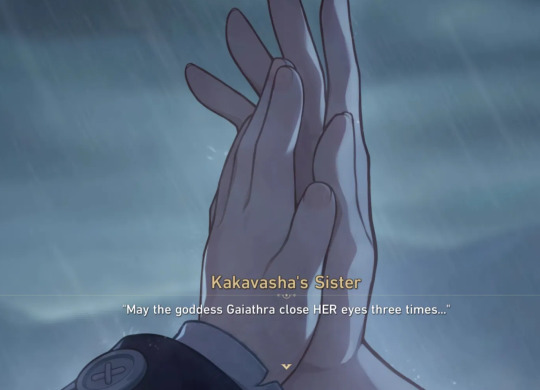
Conversely, every one of Aventurine's early negative experiences on screen appear to have been driven (at least primarily) by men.

Although the Katican tribe of course would have both men and women, the tribal societies on Sigonia appear to be on the fairly traditional side, with Aventurine's mother staying at the camp with her child while his father was the one to go out and hunt for offerings for Gaiathra. This is also supported by Aventurine asking Jade to take him to her "chief" later on. Therefore, it is likely (although of course not guaranteed) that a majority of the Katicans' army was male, and that Aventurine's early experiences with outsiders consisted almost entirely of indiscriminate pillaging and massacre at the hands of what the Avgin viewed as savage, invading warriors. In separate instances, Aventurine was traumatized by these warrior figures three times--first with the loss of his father, then his mother, and then finally his sister.

And even their hope, supposed to come in the form of the "men in black" from the IPC, completely abandoned them, leaving Aventurine once again betrayed by masculine figures that were supposed to be there to protect him. Led by Oswaldo Schneider, another cruel male authority figure, the Marketing Department of the IPC permitted the wholesale slaughter of Aventurine's people--something which we know Aventurine is now aware of.

Then, of course, the next piece of Aventurine's backstory we're given is his male slave master. I don't really need to say anything about this, do I? This man violated Aventurine's human dignity and bodily autonomy, and forced Aventurine's hand in a life or death battle for which Aventurine still punishes himself mentally, even years in the future.
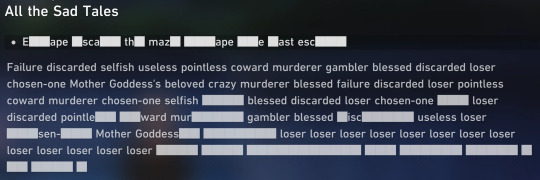
In part to escape the difficulty of his situation and rise to a position where he would have enough resources to--he thought--help his people, Aventurine joins up with the IPC. But when he attempts to make contact with a powerful man in the organization, Diamond, he is instead met by a woman, Jade, who against Aventurine's own expectations determines that she will raise Aventurine up (or use him as a tool, depending on how you currently choose to interpret Jade's motivations), granting him wealth and status beyond his imagination.
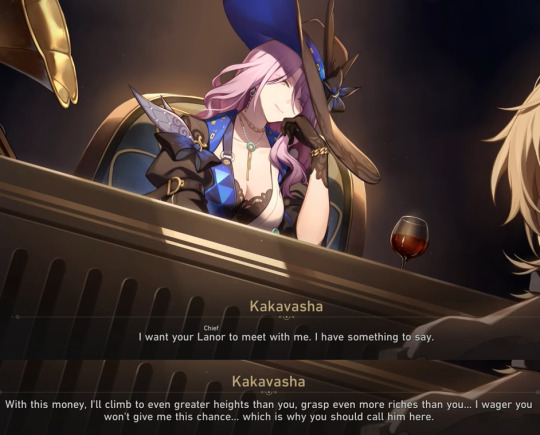
(And this line in particular is interesting, because you can take it one of two ways: 1) Aventurine comes from a patriarchal planet that traditionally put men into positions of power [thereby making his own slavery an emasculating act, aligning him further with disenfranchised women]; thus, he is making the assumption that to get anywhere in this organization, he will need to work with a man; or 2) He actually was counting on Jade taking his bet and helping him right from the beginning, because Aventurine perceives women as inherently more likely to protect and aid him than men would be.)
In the end, Jade does exactly as she claims she will, launching Aventurine into a position of power while also closing golden handcuffs around his wrists. She positions herself not only as his supervisor, but as his advocate and ally. She entrusts him with her Cornerstone, a sign of significant faith in his abilities. She even seems to be keenly aware of his bias towards the mother figure, referring to him as "child" in their conversations.

Whether this is genuine or a manipulation tactic can certainly be debated (and I'm not inclined to think at this point that Jade is a genuinely good role model or selflessly supportive person in Aventurine's life), but whatever the case, women are the only people Aventurine even remotely considers to be "in his corner."
We see this even earlier, in Aventurine's call to Topaz. Like with the example of his mother and sister, Aventurine trusts in Topaz's ability implicitly, and considers her above anyone else when it comes to completing the mission in Penacony.

Although of course we don't know if Aventurine has any other friends or allies among the Strategic Investment Department, it seems very likely that Topaz, yet another woman, is the one he is closest with. At the very least, she is the only IPC character (so far) that Aventurine has a complimentary voice line for, one that shows his respect for her talent:

Over and over again, the story aligns Aventurine with female figures in positions of authority, and demonstrates that he is comfortable (although maybe not too comfortable, in the case of Jade) with relying on them and trusting their judgment, just as he did with his mother and sister.
And this pretty much goes off the charts in Penacony, where Aventurine has more involvement with the female cast than virtually any other non-female character (even the Trailblazer!). We set the pattern off right away, with Aventurine immediately being placed into a negotiation situation with Himeko, respecting her role as the Express's leader and working to get himself aligned with the Express by acquiescing to her request for support.
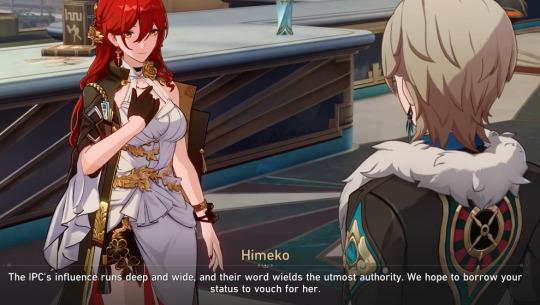
Then there's the fact that Aventurine is the one who finds Robin's body, an event which, although he didn't let it show too much, was almost certainly traumatic for him, given the violent death of his own sister.
Next, twice in Penacony's story, we see Aventurine seek out Sparkle for information. He may not personally like her and her comments may be both racist and dehumanizing, but Aventurine does rely on her--being the only character explicitly seeking her aid, which no one else in Penacony seems to want.
In 2.0...

And in 2.1.
Now, say it with me, guys: Aventurine built an entire portion of his grand plan around the idea that if he looked pathetic enough, a female character would absolutely come and help him. And sure enough, the women come through for him, always! Sparkle gives him the exact last clue he needs to confirm his belief that he could use "Death" to reach the true Penacony, sealing the deal for the rest of his plan.
His plan which also hinged significantly on Black Swan's involvement too, another woman that he views as, if not trustworthy, then at least intelligent and hyper-competent.
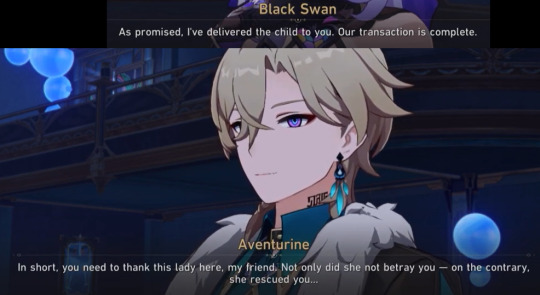
Contrast all this, of course, with the treatment Aventurine receives at the hands of Sunday, the lone opposing male character he faces in Penacony.
Sparkle implies that Sunday would humiliate Aventurine in an unmistakably sexual and degrading way, and Sunday himself professes this same desire to see Aventurine humiliated.
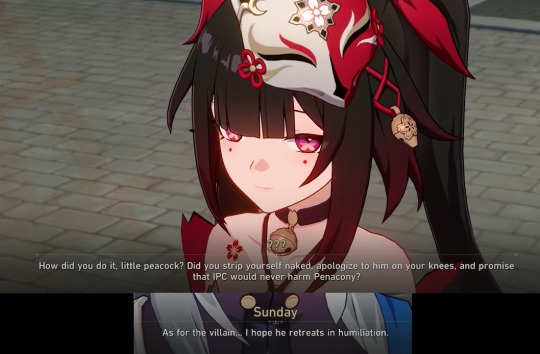
Then we're "treated" to the moment in which Sunday uses the Harmony's (or perhaps actually the Order's?) power against Aventurine, in a scene which is supposed to reflect an interrogation but is also, very clearly, another nonconsensual violation of Aventurine's bodily autonomy and dignity by a man. While ostensibly seeking confirmation of the Cornerstone ruse, Sunday instead subjects Aventurine to unnecessary questions about his past on Sigonia, which recall and force Aventurine to re-endure memories of his trauma.

Even if this is what Aventurine prepared himself for and planned to have happen, the pain he experiences is very real, and he suffers both the physical and emotional consequences of Sunday's assault all the way up to his "Death" and possibly even beyond.
(Also, Sunday fans please don't get too up in arms with me for this; I also like Sunday! It's okay for characters to be morally grey!)
I think there's one other interesting example I would bring up here too, and that's Aventurine's conscious decision to weaponize his own masculinity against the Trailblazer. Through the 2.0 and 2.1 Trailblaze missions, Aventurine deliberately acts in an off-putting manner to the Astral Express crew, particularly the Trailblazer, in order to build up to the 2.1 climax where the Trailblazer is supposed to view him as an unrepentant villain and attack him without hesitation.
In order to achieve this uncomfortable, villainous effect, what does Aventurine do? Exactly what other men have done to him.
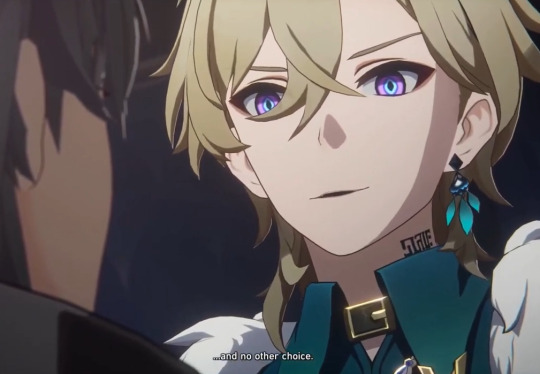
This is especially apparent if you're playing Stelle because of the ingrained societal taboo of a man entering a woman's personal space without consent, but even as Caelus, it is very clear that Aventurine is leveraging behaviors typically used to show dominance: In a complete 180 to all Aventurine's other body language in the game (normally quite withdrawn, frequently in defensive postures with his arms crossed or hand behind his back, almost always standing several feet away from other people), Aventurine violates the Trailblazer's personal bubble, looming over them (Caelus was sitting in this cutscene, lol), forcing eye contact, and commanding the space while informing them that they will have no choice.
For someone who was hunted, enslaved, had his movements restricted with chains, and due to his own slight stature has very likely been towered over by others who were intentionally asserting their power over him all his life, it is clear that Aventurine associates dominant, typically more masculine-coded physically-imposing behaviors with discomfort and even villainy.
Any girl who has ever had a man loom over her like this will realize very quickly: Aventurine wanted to make himself scary so he made himself act more like a bad man.
(Yes of course I know "not all men." I'm not saying every man behaves in this domineering way or that women cannot be domineering too, obviously, just that Aventurine had a very specific image in mind when constructing a "villainous persona," and the physically controlling tactics most typically used by aggressive men toward women was his immediate go-to.)

But where does that leave Dr. Ratio, the one male character actually on Aventurine's side?
Frankly, I don't want to derail my post about how intensely Hoyo chose to hammer on the message of "Women will protect you" in Aventurine's story with a discussion about a mlm ship, but the take-away here is going to lead in that direction anyway--so yes, Dr. Ratio is the exception.
What is interesting is that he does not come across as an exception at first, and in fact initially appears as another male character being rude and dismissive to Aventurine. Like, there are still people out there calling Ratio an unrepentant racist for this one.

Of course, it's later clarified that this is an act--likely even these insults were scripted specifically to give Sunday's spying ears the "insight" he needed to exploit Aventurine during the interrogation.
But even though it is an act, Aventurine still has noticeable trouble putting his faith in Ratio. He does genuinely doubt him a few times, despite knowing that they are working together to fool the Family.
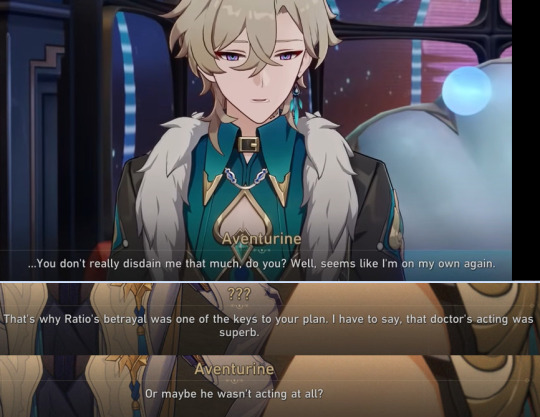
Even his voice line about Ratio confirms that he doesn't think Ratio particularly cares for him; rather, he thinks Ratio simply tolerates him because he's slightly less unintelligent than those around them.
Ultimately, the entire act with Ratio ends up being a mirror of the real scenarios Aventurine has been experiencing with men his whole life (at least as far as we are shown his life). Men abandon him to fend for himself (unwillingly, like his father, or willingly, like Diamond leaving Aventurine to deal with Penacony alone on the inside). Ratio keeps leaving Aventurine completely alone. Men attempt to humiliate him and violate his boundaries (like Sunday and his slave master). Ratio insults Aventurine's appearance and intelligence repeatedly. Men betray him (like Oswaldo Schneider and his men leaving the Avgin to die). Ratio "betrays" him.
I'm not saying when Aventurine devised the plan for their act, he consciously drew up a list of all the ways men had hurt him in the past and had Ratio re-enact them one by one, but like... that's what happened, whether or not Aventurine intended it.
And okay, the shrinking scene in Dewlight Pavilion was just for fun and probably only slightly fetishy, the devs promise; yes, it was supposed to be a joke! ...But it's also not a mistake that this is yet another instance of a male character in a glaringly metaphorical position of power over Aventurine. Aventurine's tiny in this scene! He's completely vulnerable! He's in a dangerous position and the male character could very much hurt him in this moment.

But Ratio doesn't. (In fact, his line here is supposed to be sarcastic, very ha ha--but also, what is Ratio really saying? "I won't do anything to you without your express consent." What a good guy.)
Virtually everything negative that we see in 2.1 is Ratio doing these things as an act at Aventurine's own request. He doesn't actually disdain Aventurine; his own voiceline about Aventurine reinforces that he sees Aventurine as talented and intelligent.
Whatever you think he was apologizing for in their early scene, he's the only person we're ever shown in-game apologizing to Aventurine at all.
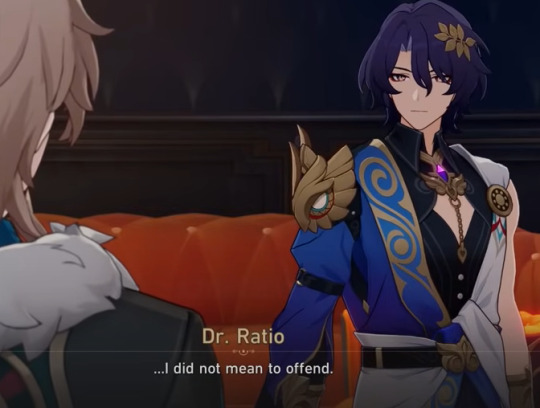
He worked hard to "betray" Aventurine but only as he was instructed to do, and immediately checks in on Aventurine's well-being afterward, even urging him to give up the plan if it becomes too much to handle.
And then, of course, there's the note: "Do stay alive. I wish you the best of luck."
After this point, it cannot be denied that Ratio is unequivocally on Aventurine's side, wants to help him, and is not doing so out of any sense of self-gain but largely because he is a good person who simply cares about Aventurine's fate. By the end of 2.1, it can no longer be doubted that Ratio is the exception to the "gender rule" of Aventurine's life, which--the story shows us again and again--was that guidance, protection, and care for Aventurine come from women, while men repeatedly represent dismissal, betrayal, or pain.
Ratio is, at least as far as Aventurine's story shows us, the proof that men can be good, that things are not as black and white in Aventurine's life as they might appear, and that--if you do choose to ship him with or see Aventurine as attracted to men--his attraction could be validated (and potentially reciprocated) by a male figure who would not bring additional harm to Aventurine's life. Aventurine makes the final decision to live after seeing Ratio's note--the exception to the rule ultimately proves to be the last piece needed to keep him alive.
But I promised I wasn't going to derail my own post about w o m e n, so let me get to the final point, and the one I really wanted to talk about: Although Ratio gets virtually all the credit for "saving" Aventurine in the fandom, Aventurine was actually saved by, you guessed it, another woman.

Not going to lie, the reason I started this post was specifically because I wanted to talk about how Acheron and Aventurine's dynamic was completely unexpected but actually fits flawlessly with the theme of feminine guidance in Aventurine's story.
Despite the fact that Aventurine made Acheron's life much harder and actively used her as a chip in his grand gamble, she doesn't blame or chastise him for those actions. Although she expresses some incredulity that Aventurine is actually that lucky, she then turns around and congratulations him for his ingenuity, immediately supporting him despite the fact that they don't even truly know each other.
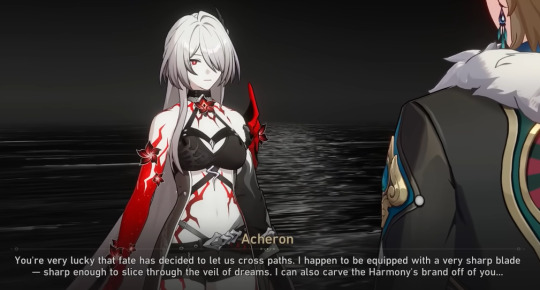
Then it gets even more interesting. Acheron, who frequently hits her companions with deep and sometimes very emotionally fraught questions, asks Aventurine: "Have you never wavered?"
We as players know for a fact that Aventurine is constantly wavering, constantly doubting himself, his luck, and whether he'll even live--or even wants to live--to see tomorrow. But we also know that Aventurine is not forthcoming about those truths, refusing to express them to anyone, even himself. The only way we hear those dark truths is through his "future" self (who by the way, is once again another male figure cutting Aventurine down--of course it's himself but it's also, from the player's perspective, once again reinforcing the message that he isn't going to find safety or kindness in an adult male presence). Aventurine almost constantly deflects and diverts when his emotions or struggles are brought to the fore (unless he's divulging them for the specific purpose of allowing someone else to weaponize them). "I'm fine," he says, like a lying liar who lies.
But he doesn't lie to Acheron.

He chooses to be completely candid with her, to lance open the deepest wound of his life--that he can win and win and win and still have lost everything. The glitz and the glamour has all been stripped away here, at the end of everything, and Aventurine finally feels safe enough to admit that he fears he has absolutely nothing in his life worth living for.
And then, we get this direct parallel: Aventurine looks to Acheron, the woman now before him, for guidance, for explanation, exactly as he looked to his sister in the past.

He needs help, he needs answers, and he is continually seeking that help from the female figures in his life, whose support and kindness echo the lost care of his mother and sister.
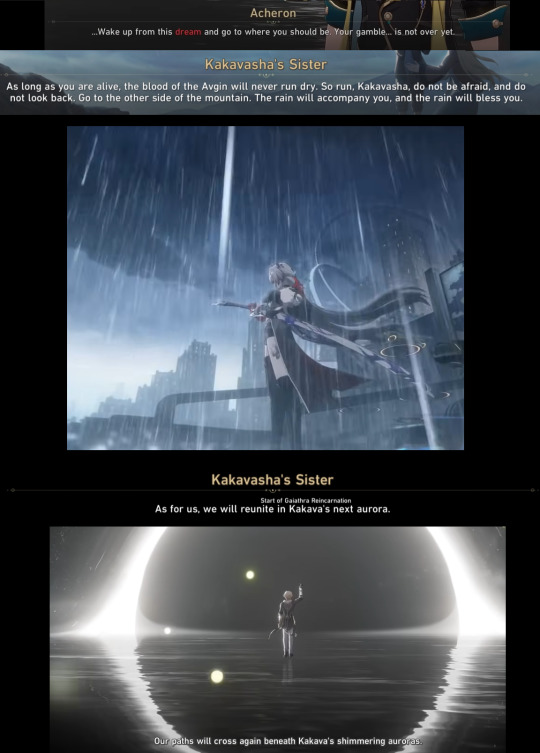
"Go where you should be," Acheron tells Aventurine, guiding him across the river of death just as his sister insisted that he flee through the rain toward life.
Look guys, Acheron's even the one who reminds Aventurine to look at Ratio's note in the first place because apparently being an emanator of Nihility gives you x-ray vision, but my girl just gets no credit at all for being Aventurine's real savior, come on now!! Yes, Ratio's note was the final reminder Aventurine needed that someone would be waiting for him on the other side, but Aventurine would never have even gotten to the point of being willing to read that note if Acheron hadn't stepped in and provided him an answer to his question.
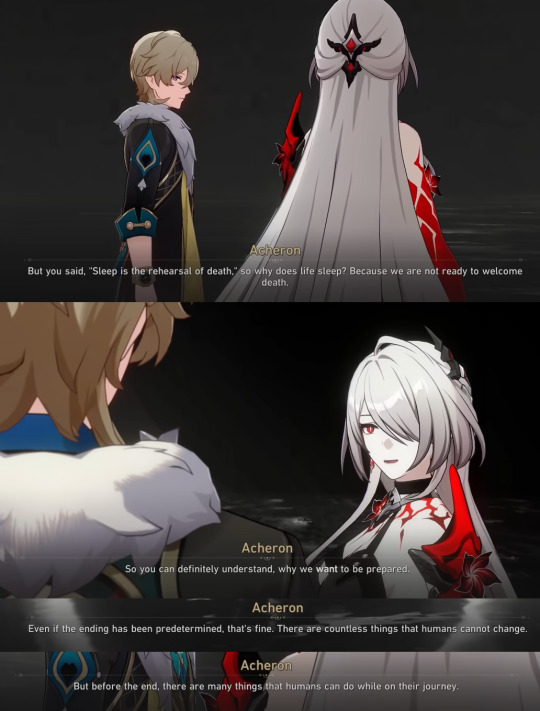
She feeds him back his own answer: "Why does life slumber? To rehearse the death for which we are not currently prepared." It is Acheron who reminds Aventurine that giving into the Nihility is pointless, and that rather than simply embracing a meaningless death, it is up to humanity itself to find and make meaning by living. It's this, not Ratio's note, that Aventurine gives as his reason for choosing to go on when asked by his own younger self. It's Acheron's words that finally give Aventurine an answer--why do we live just to die? Because there are people we can still make proud. Because when we go into death, we should do so with our heads held high, having achieved our own sense of purpose in this life.
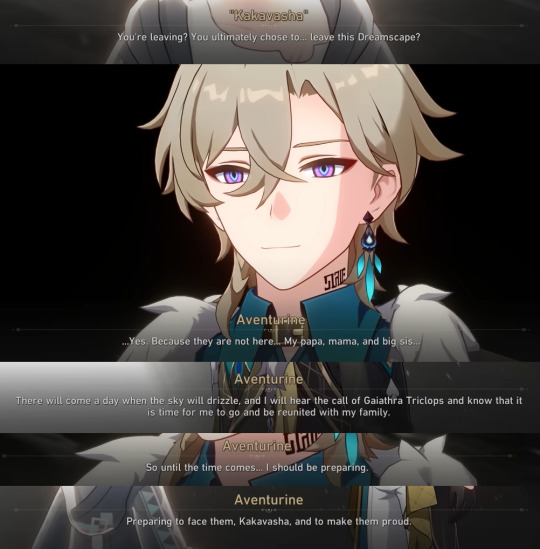
Ratio gave Aventurine a promise: Someone is waiting for you to come back.
But Acheron gave Aventurine a reason: If life is inherently meaningless, doesn't that just mean you are free to give it meaning yourself?
She saved him, as women have been saving him all his life.
Anyway, this has already been horrendously long, but really what I wanted to say is that I think it is absolutely fascinating how consistent Aventurine's writing is when it comes to portraying where his support comes from and who he seeks guidance from. (Psst, just in case you still haven't figured it out, it's women!) In virtually every instance we are shown, we see the message reinforced that women are Aventurine's greatest allies and role models, while male figures are continually positioned to intentionally or unintentionally let him down and cause him distress.
"But women playing the supporting role to a male character is nothing new, Star, why are you so excited by this?"
Because the role women are playing in Aventurine's life is not the subservient supporter and emotional crutch role that female characters all too often play to male counterparts. None of the women in Penacony or Aventurine's past were there to do the emotional labor for him, to be a trophy or prize, or to cater to his needs. They don't exist solely to help him fulfill his character motivations; they aren't following him around waiting for his next request as their only role in the plot.
Instead, with Aventurine's story, we almost have an inversion of gender roles, where the male character eschews the stereotypical "men are leaders, fighters, and stoic heroes" archetype. Instead, no matter how hard he tries to hide it and keep a stiff upper lip, it is clear from 2.0-2.1's story that Aventurine is a deeply insecure, lonely, and explicitly traumatized survivor of genocide, slavery, and exploitation. Unlike most male characters, who are very rarely portrayed as genuine victims--because come on, shouldn't men be strong enough to fight back? Shouldn't men be able to shrug it off when they are hurt, emotionally or physically? (Of course I'm rolling my eyes here!)--Aventurine is belittled, humiliated, emasculated, and victimized on-screen, roles almost exclusively reserved for women, for whom surviving victimization in fiction is seen as noble.
Meanwhile, the women in Aventurine's life take on the roles traditionally given to male characters. They're both emotionally and physically his protectors. Aventurine's sister gave her life to guard his safety; Acheron ensured he could safely pass beyond the river of Nihility into the Primordial Dreamscape. They give him the tools necessary to succeed where he could not succeed on his own. His plan could never have gotten off the ground without Topaz and Jade entrusting their Cornerstones to him. The knowledge and capabilities of the women around him--not their "feminine charms"--are what allow them to help keep Aventurine on the right path even though he does waver. Even women who disrespect him, like Sparkle, still play a positive role in his life, able to provide him insight gained with their own intellect and talents.
When he has no one to rely on and doesn't know what to do, Aventurine is able to continually turn to the women around him, asking for and receiving not servitude or fawning, but their genuine wisdom and guidance.
tl;dr: If nobody else has him, Aventurine knows this random woman he met two minutes ago on the street will have him, because the women in his life literally never let him down.
(It's just so, so good, and ultimately, it should be very clear why Aventurine's story is as popular with women as it is! A+, Hoyo!)
#honkai star rail#aventurine#acheron#topaz hsr#honkai star rail meta#character analysis#there's a bit of#ratiorine#in here too#but mostly I ramble about WOMEN#thematic parallels#thematic parallels everywhere#it's long#I'm sorry but not really#sometimes you act like a normal fan#other times you're me#and write essays that wouldn't be out of place in gender studies class#also I hit the '30 images per post' limit and had to make do#please ignore the terrible merging I did of the photos#don't perceive my MS Paint job
855 notes
·
View notes
Text

Need to write a 4000 word essay and take a neurobio final before I’m done with the term and both are due Thursday so we’re going back to the procrastination doodles again
#spade pirate sabo au#sabo#my essay is kind of a banger!!#it’s a Japanese literature class#something something the maintenance of systems of power and belief#through the idea that sight and knowledge are power#which interfaces interestingly with the supernatural which by virtue of its unknowability has some inherent value greater than mortals#and how these folktales are a way for the working class common folk to fantasize about the higher class and nobility through storytelling
457 notes
·
View notes
Text
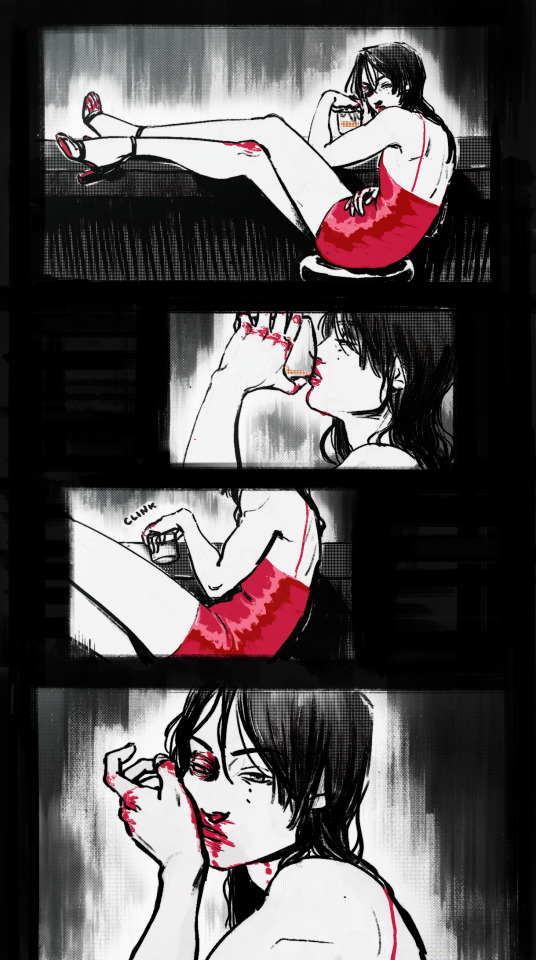
thug beatdown round 2: electric boogaloo
(extras, cw flashing gif:)
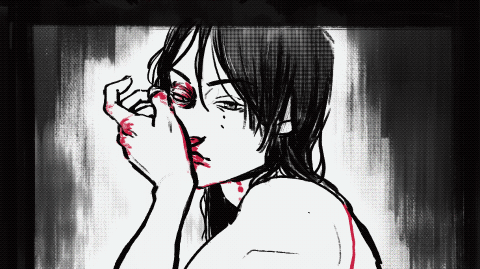
alt:

the fit:
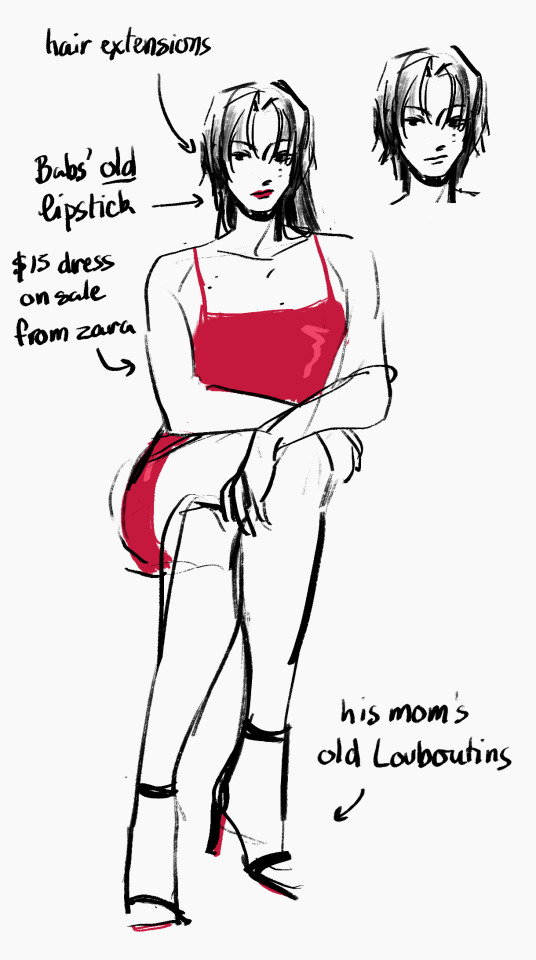
#tim drake#dc#sart#cw flashing#im grateful to the femme tim people for indulging me bc im back on my bullshit#long hair tim!!! LONG HAIR TIM!!!#if dick can have a long hair moment so can tim#further#as a canonical nightwing fan i think tim would at some point try to emulate that (also as a possible successor to the mantle)#(altho the nightwing!damian to batman!cass art i saw once also lives rent free in my mind)#AND if we track the progression of tim's hair from robin to red robin#this is the natural conclusion#in this essay i will—#aside but altho the only time i've seen jack drake drinking in the comics it was beer#we're gonna pretend he was fond of whiskey for the Aesthetic#also traditional upper class white man things#and tim drinks whiskey as a begrudging homage to the father he never really got to share drinks with beyond that one time he got magically#aged up#((i got a new dress and i thought tim would look nice in it))#god i can finally think about other things now
3K notes
·
View notes
Text
Since I finished Bloodborne last stream, I need to figure out what from my list should come next as far as games to play, so here's a poll!
#streaming#Stream#video games#soulsborne#grad student#livestream#alien isolation#cyberpunk 2077#class essay#small streamer#twitch streamer#twitch#Elden ring#Sekiro#sekiro shadows die twice#inside#Mortal kombat 1#mk1#baldur's gate 3#goodbye volcano high
14 notes
·
View notes
Text
Tired Ghost
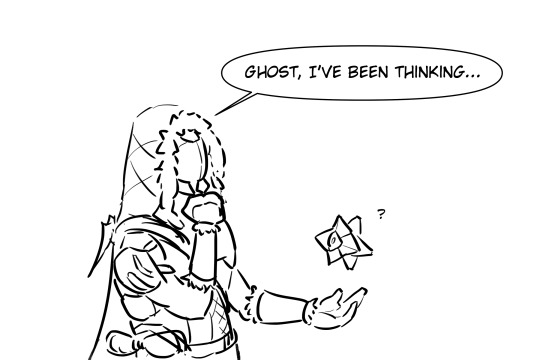
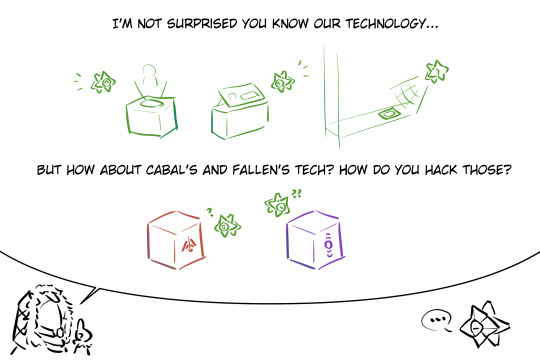
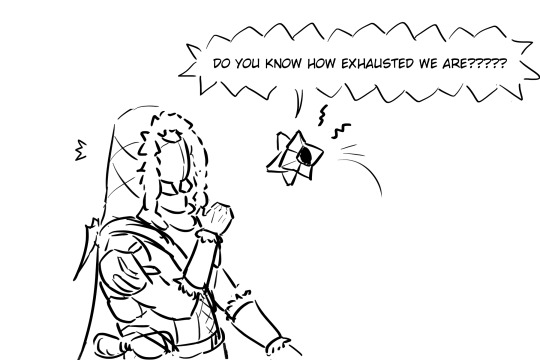


#i don't wanna spend too much time on this#(wrote an essay about how i thought vanguard hacking kit was developed)#yep that's not lorem ipsum#i just wanna see ghost complaining don't judge me too much#i didn't take history class in the ishtar collective (TM) those are all ooc don't actually read into that#if you actually know what im saying then you'd know i probably failed my computer security lesson#also the traveller probably gave them similar tech so their physical architecture should be similar#also ur a nerd lol#destiny 2#destiny hunter#destiny ghost#destiny 2 art#my art
789 notes
·
View notes
Text
It's very interesting that queen of tears is playing so hard into the "these characters were born to love each other" notion. It's repeatedly empathised (and although in a comedic vein) by haein and hyunwoo and in their inability to let each other go no matter how hard things get. At the same time with the flashbacks to how they were each other's first loves and how the osts really point to the two of them being the "one" for each other, it really speaks to how much these characters were meant to be in each other's lives, essentially soul mates, destined to be together.
What's refreshing though is that they said okay you two might be soul mates but that doesn't mean your relationship doesn't take work and that you are going to drift so far apart that it's going to feel like love no longer exists between the two of you. They said hey, being destined for each other and having to still put in the effort to make your relationship work are not mutually exclusive and should never be because that's not how the real world works. But hey, put in the effort, talk, listen, learn, and grow and you'll see why you two were born to love each other.
#queen of tears#kdrama#I could write essays about this show#on why haein and hyunwoo are so perfectly written#and why this show is such a master class in writing what a marriage can be like#even when theres so many other dramatics going on
441 notes
·
View notes
Text
so fucking funny to me when people talk about tlt setting like everyone in the whole society is sorted into being either a necromancer or a cavalier. like yes necromancy is an inborn trait. but cavalier? that's a wholeass job. that's a career. assigned butler at birth
#the locked tomb#to be clear this isn't vagueing aboht anyone's analysis essays or anything#this is about a kidfic that assigned necrocav roles to all the children#not even as pairs#just like. this baby is a necromancer and this baby is a cavalier#I think sometimes. we get so caught up in the gender analysis of it all we whiff on the class dynamic
816 notes
·
View notes
Text
People will say "I have not seen seasons xyz of supernatural" and then write meta about it anyway. And it will be the worst shit you have ever read
#i have said it before but this is not high school english class#if you didn't do your reading then do not write the essay
435 notes
·
View notes
Text
my biggest dracula movie/tv adaptation gripe is that they never. Ever. get jack seward right. and they seldom get arthur and quincey right. but nobody does jack the way he should be: young, handsome, charming, smart, deeply observant, driven by curiosity, and devoted to a fault.
the hero boys commonly feel like an afterthought by directors and screenwriters - like they're interchangeable, easily omitted or substituted, swallowed up by abraham van helsing's significance. it's really unfortunate, especially since they each feel, in the book, so lovingly created and characterized. they each have importance and i wish more people understood that.
#dracula#dracula daily#it's the time of year when i yell and cry about my boys again#jack seward#deserved so much better#arthur holmwood#i wrote an essay for a college class about him once#and how much i love him and why he deserves more attention#quincey morris#WHOM MINA NAMED HER SON AFTER#hero boys
232 notes
·
View notes